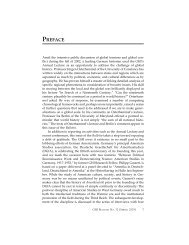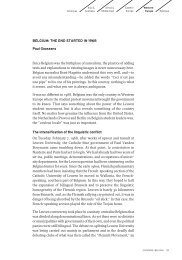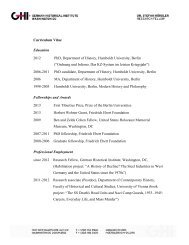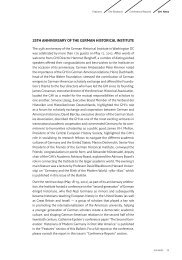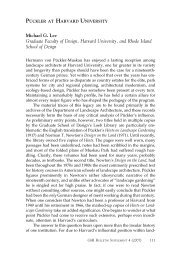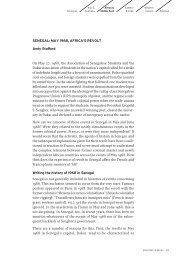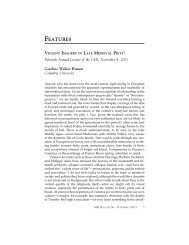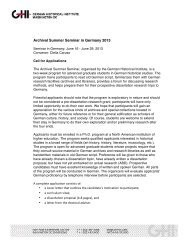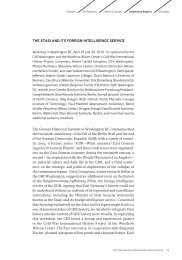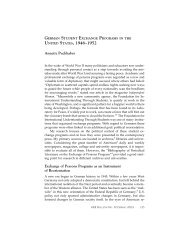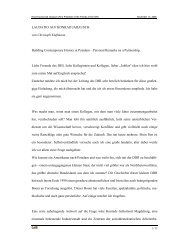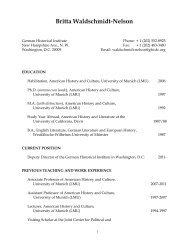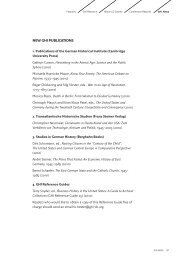LIVES IN LIMBO: STATELESSNESS AFTER TWO WORLD WARS ...
LIVES IN LIMBO: STATELESSNESS AFTER TWO WORLD WARS ...
LIVES IN LIMBO: STATELESSNESS AFTER TWO WORLD WARS ...
You also want an ePaper? Increase the reach of your titles
YUMPU automatically turns print PDFs into web optimized ePapers that Google loves.
Features<br />
Forum GHI Research Conference Reports GHI News<br />
<strong>LIVES</strong> <strong>IN</strong> <strong>LIMBO</strong>: <strong>STATELESSNESS</strong> <strong>AFTER</strong> <strong>TWO</strong><br />
<strong>WORLD</strong> <strong>WARS</strong><br />
Miriam Rürup<br />
GERMAN HISTORICAL <strong>IN</strong>STITUTE<br />
“The passport is the most noble part of the human being. It also does<br />
not come into existence in such a simple fashion as a human being<br />
does. A human being can come into the world anywhere, in the most<br />
careless way and for no good reason, but a passport never can. When<br />
it is good, the passport is also recognized for this quality, whereas<br />
a human being, no matter how good, can go unrecognized.” Thus<br />
wrote Bertolt Brecht in his Refugee Conversations in 1940, still deeply<br />
affected by his own experience of exile. 1 His view illustrates the vital<br />
importance that a seemingly simple administrative act—the issuance<br />
of personal identification papers—could acquire. The possession of<br />
correct papers legitimated a person’s right to be accepted as a human<br />
being and as part of the collectivity defined by the nation-state. The<br />
passport, which has been the most important document for regulating<br />
the interstate movement of people since the First World War,<br />
quickly became the most obvious symbol of this belonging, offering<br />
proof and recognition of one’s status.<br />
The reverse was also true: The lack of valid papers expressed one’s<br />
lost link to human society. Brecht’s dark observation, therefore,<br />
highlighted the logical conclusion of a historical process that Gerard<br />
Noiriel has termed an “identificatory revolution.” 2 The stateless person<br />
emerged as a sort of inevitable byproduct of the nationalization<br />
process that began in the nineteenth century with the rise of European<br />
national movements which defined the state as a nationally<br />
homogeneous entity. Within these newly conceived states, belonging<br />
became synonymous with possessing the correct nationality, verifiable<br />
through the proper documentation, which was necessary to open<br />
paths to social participation and interaction with the state’s citizenry. 3<br />
Consequently, those who were displaced by flight, deportation or<br />
other means during the two world wars and thereby lost their formal<br />
1 Bertolt Brecht, Flüchtlingsgespräche<br />
(1940; Berlin,<br />
1961), 1 (translation by<br />
Author).<br />
2 Gerard Noiriel, Die Tyrannei<br />
des Nationalen: Sozialgeschichte<br />
des Asylrechts in<br />
Europa (Lüneburg, 1994).<br />
3 Definitions of citizenship are<br />
culturally determined and<br />
change over time. In premodern<br />
times, citizenship<br />
referred to membership in a<br />
municipality, but a few new<br />
concepts emerged after the<br />
French Revolution wherein<br />
nationality came to constitute<br />
an institutionalized link<br />
between citizen and state. >><br />
>> See Thomas Faist,<br />
“Transnationalization in<br />
International Migration:<br />
Implications for the Study<br />
of Citizenship and culture,”<br />
Ethnic and Racial Studies<br />
23, no. 2 (March 2000):<br />
189–222. From the early<br />
nineteenth century, new<br />
citizenship laws were issued<br />
throughout Europe that<br />
defined who belonged to<br />
a state and who did not.<br />
First and foremost intended<br />
to protect citizens from<br />
being deported for reasons<br />
such as poverty, these laws<br />
were closely linked to the<br />
emerging social welfare<br />
system. In international law<br />
today, the terms citizenship<br />
and nationality are used<br />
synonymously (see Carol A.<br />
Batchelor, “Statelessness<br />
and the Problem of<br />
Resolving Citizenship<br />
Status,” paper presented at<br />
UNHCR Conference “People<br />
of Concern” (November 21–<br />
24, 1996, Geneva), yet there<br />
still are differences between<br />
them, both historically<br />
and in their qualitative<br />
essence: “Citizen” puts<br />
much more emphasis on<br />
an individual’s political<br />
status within a state and<br />
expresses more clearly the<br />
sense of his belonging to<br />
a certain group and being<br />
able to participate actively<br />
in society. “Nationality”<br />
(“Staatsangehörigkeit”),<br />
in turn, emphasizes<br />
the more contractual<br />
agreement between an<br />
individual and a state.<br />
Modern nationality typically<br />
combines these features<br />
and is—together with<br />
aspects of territoriality—one<br />
of the main characteristics<br />
of modern statehood, as<br />
Charles Maier has shown.<br />
See, for example, Charles<br />
S. Maier, “Consigning<br />
the Twentieth Century<br />
to History: Alternative<br />
Narratives for the Modern<br />
Era,” American Historical<br />
Review 105 (2000), 807-31.<br />
RÜRUP | <strong>STATELESSNESS</strong> <strong>AFTER</strong> <strong>TWO</strong> <strong>WORLD</strong> <strong>WARS</strong> 113
4 See the concise study by<br />
Andreas Fahrmeir, Citizenship:<br />
The Rise and Fall of a Modern<br />
Concept (New Haven, 2007).<br />
Thoughtfully drawing attention<br />
to the lack of research on<br />
statelessness, Fahrmeir claims<br />
that such research is vital to<br />
understanding the historical<br />
development of the concept of<br />
“citizenship.”<br />
5 Arendt herself had escaped<br />
Berlin in August 1933 and<br />
finally immigrated to the US.<br />
She lived as a political refugee<br />
and stateless person for nearly<br />
a decade until gaining US<br />
citizenship in December 1951,<br />
shortly after finishing The<br />
Origins of Totalitarianism. For<br />
broader insight into Arendt’s<br />
life, see Elisabeth Young-Bruehl;<br />
Hannah Arendt: Leben, Werk<br />
und Zeit (Frankfurt am Main,<br />
2004). Arendt first processed<br />
the experiences of flight,<br />
detainment and statelessness<br />
in her essay “Wir Flüchtlinge”<br />
of 1943. (See the collection of<br />
her political essays, Hannah<br />
Arendt, Zur Zeit. Politische<br />
Essays, ed. Marie-Luise Knott<br />
(Berlin, 1986), 7–21. It was<br />
first published as “We Refugees,”<br />
Menorah Journal (1943).<br />
Her interpretations of the<br />
experience here and in later<br />
works are linked to her own<br />
biography and at the same time<br />
rooted in the broader historical<br />
context.<br />
6 Chief Justice Earl Warren, in<br />
Trop vs. Dulles, 356 US 86<br />
(1958), 107; the phrase was<br />
coined by Hannah Arendt in<br />
The Origins of Totalitarianism<br />
(San Diego, 1968 [first: New<br />
York, 1951]), 296. For a short<br />
overview of the meaning<br />
of statelessness in Hannah<br />
Arendt’s major study, see<br />
Miriam Rürup, “Staatenlosigkeit<br />
als Entmenschlichung.<br />
Hannah Arendt,<br />
state affiliation constitute an unintended result of the nation-state<br />
system. Indeed, these stateless people seem to be the mirror image<br />
and negative counterpart of citizens. Yet, although the history of<br />
citizenship and nationality has been well researched, these stateless<br />
groups have largely been left out of it. 4 In fact, they only came<br />
into view after the historiographical gaze recently shifted toward the<br />
transnational, revealing groups that transcended national boundaries<br />
and were, in some cases, stuck outside them. Responsibility<br />
for such persons fell to supranational organizations. Statelessness<br />
is basically a state of legal limbo, of mostly temporary non-status, of<br />
not belonging to any of the modern national frameworks. Whether<br />
a product of free will or force, statelessness always expresses a form<br />
of marginalized existence in the middle of society. Hannah Arendt 5<br />
describes the exclusion of a stateless person from a community of<br />
citizens as a violent act that denies him even the “right to have rights,”<br />
whereas citizens can at least fight for their rights. 6<br />
My research project traces how statelessness arose and how people<br />
and institutions came to grips with this challenge in Europe after<br />
each of the world wars. In particular, it focuses on how these developments<br />
shaped international relations and on the framework<br />
within which they were addressed, which from 1948 was supposed<br />
to apply norms such as those formulated in the Universal Declaration<br />
of Human Rights.<br />
The very diverse and heterogeneous group of stateless people constituted<br />
the counterpart to passport holders. From the First World War<br />
on, passports provided proof of identity and nationality. 7 While the<br />
passport first appeared as part of the democratization process during<br />
the French Revolution and mainly served as a travel document, 8<br />
it became the modern symbol par excellence for defining inclusion<br />
and exclusion in the nation-state system in place by the twentieth<br />
Elemente und Ursprünge<br />
totaler Herrschaft (1951),”<br />
in Gewalt und Gesellschaft:<br />
Klassiker modernen Denkens<br />
neu gelesen, ed. Uffa Jensen,<br />
Habbo Knoch, Daniel Morat,<br />
and Miriam Rürup<br />
(Göttingen, 2011), 226-37.<br />
7 Mark B. Salter, Rights of<br />
Passage: The Passport in<br />
International Relations<br />
(Boulder, 2003), 4. See this<br />
also on the “Visa-System”,<br />
following suit upon the<br />
establishment of the<br />
Passport Regime.<br />
8 On this development, see<br />
Andreas K. Fahrmeir, “Die<br />
moderne Staatsbürgerschaft<br />
und ihre Grenzen:<br />
Anmerkungen zu T. H.<br />
Marshalls ‘citizenship’-<br />
Konzept,” Historische<br />
Zeitschrift 286, no. 3<br />
(2008): 641–55; and John<br />
Torpey, “Passports and the<br />
Development of Immigration<br />
Controls in the North<br />
Atlantic World during the<br />
Long Nineteenth Century,”<br />
in Migration Control in the<br />
North Atlantic World: The<br />
Evolution of State Practices<br />
in Europe and the United<br />
States from the French<br />
Revolution to the Inter-War<br />
Period, ed. Andreas K.<br />
Fahrmeir, Olivier Faron,<br />
and Patrick Weil (Oxford,<br />
2003) 73–91, 78.<br />
114 BULLET<strong>IN</strong> OF THE GHI | 49 | FALL 2011
Features<br />
Forum GHI Research Conference Reports GHI News<br />
century. The experience of statelessness as a life in legal limbo thus<br />
corresponds to the ever-growing importance of the passport system<br />
in the twentieth century. After the “long nineteenth century,” an era<br />
of national movements and the attendant emergence of new nationstates,<br />
the twentieth century was an era not only of world wars but<br />
also of nation-states in flux, newly forming, collapsing, and being<br />
reconfigured. Numerous violent, but also internationally sanctioned<br />
revisions of territories and borders accompanied these developments,<br />
eventually resulting in a growing number of stateless people with no<br />
legal protections. 9<br />
In my overall project, I focus on the historically and culturally specific<br />
practices of actors who experienced or dealt with statelessness.<br />
The geographic starting point is Switzerland, insofar as it was the<br />
center of all international efforts to address statelessness—the first<br />
country to provide a setting for international discussions in each of<br />
the two postwar periods that saw the European state system in tatters.<br />
International organizations such as the League of Nations and<br />
the International Committee of the Red Cross, the first institutions<br />
to react to the problem of statelessness on a large scale, had their<br />
headquarters in Geneva. However, the supranational decisions made<br />
there then had to be applied within the different nation-states, so<br />
my project concentrates on Germany (in the post-1945 era, on West<br />
Germany) and the United States to examine how this worked in these<br />
two Western nation-states.<br />
This geographic emphasis corresponds to a three-step approach in<br />
researching the subject of statelessness. First, I focus on the supranational<br />
level, that is, the discussions of the League of Nations and<br />
later the United Nations on the issue of statelessness that eventually<br />
led to broad changes in international relations and international law.<br />
Next, I analyze the positions and approaches of the nation-states in<br />
direct interaction with the supranational institutions. Finally, I turn<br />
to the implementation of international agreements on the nationstate<br />
level, examining the everyday practices and experiences of the<br />
actors and groups involved: the stateless themselves, individuals<br />
and support groups who worked with them, and national as well as<br />
supranational organizations.<br />
In this introduction to my project, I begin with a brief sketch of the<br />
fundamental causes of statelessness as well as the national and international<br />
responses that typified or reshaped the problem. In the<br />
second section, I build on this framework by examining three brief<br />
9 Enzo Traverso, for example,<br />
sees the stateless person<br />
as the epitome of the<br />
twentieth century, which<br />
he describes as a period<br />
of “European Crisis”; see<br />
Enzo Traverso, Im Bann der<br />
Gewalt: Der europäische<br />
Bürgerkrieg 1914–1945<br />
(Munich, 2008), esp. 38<br />
and 51. Eric Hobsbawm<br />
makes a similar point in<br />
his The Age of Extremes:<br />
A History of the World,<br />
1914- 1991 (New York,<br />
1994), esp. 50-51.<br />
RÜRUP | <strong>STATELESSNESS</strong> <strong>AFTER</strong> <strong>TWO</strong> <strong>WORLD</strong> <strong>WARS</strong> 115
ut consequential periods that made statelessness a characteristic<br />
problem of the twentieth century. In the third section, I present the<br />
main perspectives that inform my research, using concrete examples<br />
to address the following questions: How was statelessness dealt with<br />
on a supranational level? What did it mean for those who experienced<br />
statelessness? How did cultural imaginations process the historical<br />
experience of statelessness? Finally, to what alternative, that is, postnational,<br />
concepts of belonging did the experience of statelessness<br />
lead in some cases?<br />
10 For one of numerous examples,<br />
see Bericht über die<br />
Sitzung des Expertenkomitees<br />
Terminologie am 15. August<br />
1956 in Vaduz, Archives of the<br />
Comité International du Croix<br />
Rouge, Geneva, BAG 234.<br />
11 See, for example, the novel<br />
of B. Traven, first published<br />
in 1926: Das Totenschiff: Die<br />
Geschichte eines amerikanischen<br />
Seemanns (Berlin, 1930). For<br />
the cinematographic example<br />
of Laurel and Hardy, see<br />
Miriam Rürup, “Staatenlosigkeit<br />
als Utopie? Laurel und Hardy<br />
auf dem Atoll,” Werkstatt Geschichte<br />
52 (2009): 69–86.<br />
Writing a history of statelessness in Europe requires both legal<br />
and cultural approaches. Jurisdictions’ methods for addressing the<br />
problem of statelessness always stood at the beginning of discourses<br />
concerning the issue because the first definitions were legal. Contemporaries<br />
utilized a variety of terms to categorize and grasp stateless<br />
persons as such, describing them as persons of “abnormal status,”<br />
“homeless,” a “new class of international people,” “undesirables,”<br />
and so on. 10 The leitmotif of all these discussions was clearly first<br />
to define, then solve. Only after legal delineation did “stateless” and<br />
related terms such as “homeless” and apatride (French for “stateless”)<br />
enter broader societal discourses about people who, for various<br />
reasons, had lost their citizenship. However, we cannot describe<br />
and study statelessness in legal terms alone but must analyze the<br />
legal approaches themselves since they were culturally constructed<br />
and subject to historical change. If, instead of focusing too narrowly<br />
on legislation and state bureaucracy, we observe interpretations of<br />
statelessness and the ways such ideas were mirrored in discourses at<br />
a broader societal level, we can find many reflections of statelessness<br />
in literature and film. Moreover, these cultural responses influenced<br />
the legal discourses that had initially spawned them. 11<br />
To flesh out the three-step approach, this project therefore goes beyond<br />
the mere reconstruction of the legal history of statelessness to investigate<br />
the experience of statelessness on legal, cultural, and everyday<br />
levels after 1918 and 1945. Besides laying out the causes of widespread<br />
statelessness after both world wars, the project focuses on solutions<br />
that newly emerging supranational organizations such as the League<br />
of Nations came up with and how the discussions they engaged in<br />
changed the arena of international politics. Next, it seeks to shed light<br />
on how the nation-states applied the internationally agreed-upon solutions<br />
in international conventions and other such accords. Then, to get<br />
as close as possible to the experience of statelessness, it turns towards<br />
those most affected by statelessness—that is, the stateless themselves<br />
116 BULLET<strong>IN</strong> OF THE GHI | 49 | FALL 2011
Features<br />
Forum GHI Research Conference Reports GHI News<br />
and those who sought to help them. One way to do this is to analyze<br />
lawsuits filed to combat discrimination against the stateless—such as<br />
disputes over property, social welfare, pensions, and so on. With this<br />
multistep approach, it is possible to see how a seemingly marginal<br />
phenomenon such as statelessness lay at the heart of much broader<br />
issues including the question: Who, in times of crisis, defined state<br />
affiliation and how? More importantly, considering the growing power<br />
and relevance of international politics after the two world wars, how<br />
vital was national belonging in the modern and crisis-ridden system of<br />
nation-states? What relevance did collective belonging in a presumably<br />
modern civil society resulting from the experience of World War II still<br />
possess in the postwar years? What does research on statelessness reveal<br />
about the historically changing conceptions of what a modern state<br />
collective—and the individual’s role within it—could and should be?<br />
In recent years, a number of scholars have done research on citizenship,<br />
nationality, and documenting identity. Some works compare<br />
different national approaches to citizenship laws, 12 while others concentrate<br />
on the entanglements of national belonging, ethnicity, and<br />
participatory citizenship rights. 13 The development of the passport<br />
system has also been the subject of important research. 14 The most<br />
recent scholarly approaches to the relationship of citizenship rights<br />
and international politics, however, are primarily inspired by a new<br />
interest in the development of international and supranational organizations<br />
such as the League of Nations and the United Nations, 15 as<br />
well as the notion of human rights in international politics. 16 Some<br />
scholars have also done some exploratory research on particular aspects<br />
or legal issues of statelessness, such as the role of the United<br />
>> Changing the Basis<br />
of Citizenship in the<br />
Modern State: Political<br />
Theory and the Politics of<br />
Diversity (Lewiston, 2005).<br />
For a more gender specific<br />
perspective on the principally<br />
male concept of<br />
citizenship, see Kathleen<br />
Canning and Sonya O.<br />
Rose, “Gender, Citizenship<br />
and Subjectivity: Some<br />
Historical and Theoretical<br />
Considerations,” Gender &<br />
History 13, no. 3 (2002):<br />
427–43; Lora Wildenthal,<br />
“Race, Gender, and<br />
Citizenship in the German<br />
Colonial Empire,” in Tensions<br />
of Empire: Colonial Cultures<br />
in a Bourgeois World, ed.<br />
Frederick Cooper and Ann<br />
Stoler (Berkeley, 1997),<br />
263–83.<br />
14 For a great synthesis of<br />
passport research, see<br />
John Torpey, The Invention<br />
of the Passport: Surveillance,<br />
Citizenship and the<br />
State (Cambridge, 2000);<br />
though it covers a different<br />
historical era, Valentin<br />
Groebner, Der Schein der<br />
Person. Steckbrief, Ausweis<br />
und Kontrolle im Europa<br />
des Mittelalters (Munich,<br />
2004), is also of interest.<br />
15 See Madeleine Herren, Internationale<br />
Organisationen seit<br />
1865: Eine Globalgeschichte<br />
der internationalen Ordnung<br />
(Darmstadt, 2009).<br />
12 See especially Rogers<br />
Brubaker, Citizenship and<br />
Nationhood in France and<br />
Germany (Cambridge, MA,<br />
1992); and with a quite<br />
different position Dieter<br />
Gosewinkel, Einbürgern<br />
und Ausschließen: Die<br />
Nationalisierung der<br />
Staatsangehörigkeit vom<br />
Deutschen Bund bis zur<br />
Bundesrepublik Deutschland<br />
(Göttingen, 2001);<br />
see also Andreas<br />
Fahrmeir, Citizens and<br />
Aliens: Foreigners and the<br />
Law in Britain and the German<br />
States, 1789–1870<br />
(New York, 2000). For<br />
more general reflections<br />
on the history of citizenship,<br />
see Rogers Brubaker,<br />
Ethnizität ohne Gruppen<br />
(Hamburg, 2007); Charles<br />
Tilly, Citizenship, Identity<br />
and Social History (Cambridge,<br />
1996); Geoff Eley<br />
and Jan Palmowski, Citizenship<br />
and National Identity<br />
in Twentieth-Century<br />
Germany (Stanford, 2008);<br />
and Andreas Fahrmeir,<br />
Citizenship: The Rise and<br />
Fall of a Modern Concept<br />
(New Haven, 2007); as<br />
well as the essay collection<br />
edited by Christoph<br />
Conrad and Jürgen Kocka,<br />
Staatsbürgerschaft in Europa:<br />
Historische Erfahrungen<br />
und aktuelle Debatten<br />
(Hamburg, 2001).<br />
13 Examples include Thomas<br />
H. Marshall, “Staatsbürgerrechte<br />
und soziale<br />
Klassen,” in Bürgerrechte<br />
und soziale Klassen: Zur<br />
Soziologie des Wohlfahrtsstaates,<br />
ed. Thomas H.<br />
Marshall (Frankfurt a.M.,<br />
1992 [first 1949]), 33-94;<br />
Yngve Lithmann and Hakan<br />
G. Sicakkan, eds., >><br />
16 Concerning the importance<br />
of international<br />
politics inspired by<br />
human rights principally<br />
after 1945, see Jan Eckel,<br />
“Utopie der Moral, Kalkül<br />
der Macht: Menschenrechte<br />
in der globalen<br />
Politik seit 1945,” Archiv<br />
für Sozialgeschichte 49<br />
(2009): 437–84; Stefan-<br />
Ludwig Hoffmann, ed.,<br />
Moralpolitik. Geschichte<br />
der Menschenrechte im 20.<br />
Jahrhundert (Göttingen,<br />
2010); and recently also<br />
Samuel Moyn, The Last<br />
Utopia: Human Rights in<br />
History (Cambridge, 2010).<br />
RÜRUP | <strong>STATELESSNESS</strong> <strong>AFTER</strong> <strong>TWO</strong> <strong>WORLD</strong> <strong>WARS</strong> 117
Nations High Commissioner for Refugees (UNHCR). 17 Following<br />
on the heels of these studies, this project emphasizes groups who<br />
were no longer part of any nation-state, but whose mere existence<br />
helped to shape a new system of international politics after the end<br />
of the nineteenth-century Vienna System of international power<br />
relations. 18<br />
17 See, for example, Carol<br />
Batchelor, “The 1954<br />
Convention Relating to the<br />
Status of Stateless Refugees:<br />
Implementation within the European<br />
Union Member States<br />
and Recommendations for<br />
Harmonization,” Refuge 22, no.<br />
2 (2004): 31–58, 36. From the<br />
standpoint of a legal scholar,<br />
see, among others, Laura Van<br />
Waas, Nationality Matters:<br />
Statelessness under International<br />
Law (Antwerpen, 2008); Carol<br />
A. Batchelor, “Statelessness<br />
and the Problem of Resolving<br />
Nationality Status,” International<br />
Journal of Refugee Law<br />
10 (1998): 156–83; idem,<br />
“Stateless Persons: Some Gaps<br />
in International Protection,”<br />
International Journal of Refugee<br />
Law 7 (1995): 232–59; idem,<br />
“UNHCR and Issues Related<br />
to Nationality,” Refugee Survey<br />
Quarterly 14, no. 3 (1995):<br />
91–112; earlier studies include<br />
Paul Weis, Nationality and<br />
Statelessness in International<br />
Law (Westport, 1979 [first<br />
1956]). The only short study<br />
so far dealing explicitly with<br />
the history of statelessness in<br />
the United States is Linda K.<br />
Kerber, “The Stateless as the<br />
Citizen’s Other: A View from<br />
the United States,” American<br />
Historical Review 112 (2007):<br />
1–34.<br />
18 Eric D. Weitz, “From the<br />
Vienna to the Paris System:<br />
International Politics and the<br />
Entangled Histories of Human<br />
Rights, Forced Deportations,<br />
and Civilizing Missions,”<br />
American Historical Review 113<br />
(2008): 1313–43.<br />
By looking at the margins of postwar societies, we can find out more<br />
about different modes and models of belonging. For periods of crisis,<br />
a perspective on the margins of society can help us learn more<br />
about how membership in a particular human society was defined.<br />
Furthermore, it helps us untangle how individuals and nonstate<br />
organizations reconceptualized ideas of belonging on the basis of<br />
humanitarian principles. This approach brings conceptions of social<br />
belonging into a picture that eventually moves beyond nation-state<br />
affiliation to encompass such ideas as world citizenship and the<br />
growing importance of universalist ideals based on human rights.<br />
I. Causes and Responses<br />
An integral part of modern national self-understanding throughout<br />
most of the twentieth century was that adopting a different—foreign—nationality<br />
meant giving up one’s former nationality. This crucial<br />
aspect of nearly all nationality laws caused nationality changers<br />
to fall into a sort of stateless legal limbo as they waited to obtain their<br />
new nationality after giving up their old one. But what if their request<br />
failed? Or what if the grounds for granting someone a new nationality<br />
changed over time? As nation-states increasingly faced stateless<br />
people in their midst, they quickly began to seek solutions.<br />
In the two postwar periods, there were five general causes, both historical<br />
and personal, of statelessness. The first cause was the actions<br />
of states against their own citizens. Nearly all European nationality<br />
laws permitted state institutions to expatriate citizens, revoke their<br />
citizenship, or both for maintaining permanent residence abroad, accepting<br />
a foreign nationality, taking an official post in a different state,<br />
or serving in a foreign military, among other reasons. Some countries<br />
could expatriate citizens to punish them for criminal offenses or even<br />
political opposition. After the First World War and the revolutions<br />
that followed, many European countries began to pass laws that<br />
allowed them to denaturalize or denationalize their citizens. Such<br />
laws and the resulting mass phenomenon of statelessness marked<br />
a turning point in the history of the modern nation-state, which<br />
118 BULLET<strong>IN</strong> OF THE GHI | 49 | FALL 2011
Features<br />
Forum GHI Research Conference Reports GHI News<br />
erased any naive notion of the inviolability of one’s membership in<br />
the national community. 19 State-generated statelessness continued to<br />
grow in the interwar period with more European states issuing laws<br />
enabling the expatriation of unwanted citizens. Expatriation became<br />
legal in several countries long before National Socialist laws broke<br />
any remaining inhibitions on such actions in Germany.<br />
A second cause of statelessness was contradictory nationality laws<br />
that allowed some people to fall through the cracks following the<br />
dissolution of empires and the creation of new nation-states. 20 The<br />
territorial changes in Europe after World War I were dramatic: Old<br />
empires like Austria-Hungary collapsed; new nation-states such<br />
as Czechoslovakia appeared; and border regions, including Alsace-<br />
Lorraine, were transferred to other nation-states. In Eastern Europe,<br />
moderate and integrative nationality policies inspired by the Paris<br />
Treaties of 1919 as well as the Treaties for the Protection of National<br />
Minorities were supposed to prevail. Some contradictory regulations<br />
in the treaties, however, rendered people stateless without them ever<br />
leaving their homes. These international treaties, though informed by<br />
good intentions, lacked sufficient appreciation of local circumstances<br />
and therefore produced new problems in many cases. Questions of<br />
citizenship and nationality therefore became a major issue in the<br />
new transnational order. 21<br />
A third major cause of statelessness was specific to women. Until far<br />
into the twentieth century—in international law until 1957—a woman’s<br />
nationality was based on the principle of “derivative citizenship.”<br />
That is, her citizenship depended on who she “belonged to,” be it her<br />
father in her country of origin or her husband of a different nationality.<br />
This could be positive if it offered a woman a change in citizenship she<br />
desired, such as becoming a U.S. citizen by marrying one. 22 The other<br />
side of this principle, though, was that many countries automatically<br />
revoked the citizenship of women who married foreign nationals,<br />
rendering them dependent on their husbands’ nationality. This often<br />
then led to statelessness, for example, if a husband’s land of origin did<br />
not grant his wife citizenship in her own right and the marriage later<br />
ended in divorce, or if the wife had not yet fulfilled the naturalization<br />
19 For more information<br />
about expatriations,<br />
see also Ilse Reiter-<br />
Zatloukal, “Zwangsausbürgerung<br />
aus politischen<br />
Gründen: ein Element<br />
europäischer Rechtsunkultur<br />
im 20. Jahrhundert?”<br />
in Grundlagen der<br />
ö sterreichischen<br />
Rechtskultur: Festschrift fü r<br />
Werner Ogris zum<br />
75. Geburtstag, ed.<br />
Thomas Olechowski,<br />
Christian Neschwara,<br />
and Alina Lengauer<br />
(Vienna, 2010),<br />
433–58.<br />
20 For a discussion of the<br />
legally contradictory<br />
clauses concerning nationality<br />
issues in the Treaty<br />
of Versailles and in the<br />
treaties for the protection<br />
of national minorities, see<br />
Jens Boysen, “Staatsbürgerliche<br />
Optionen in Posen<br />
nach 1918,” in Deutschsein<br />
als Grenzerfahrung. Minderheitenpolitik<br />
in Europa<br />
zwischen 1914 und 1950,<br />
ed. Mathias Beer, Dietrich<br />
Beyrau, and Cornelia Rauh<br />
(Essen, 2009) ,175–88,<br />
here esp. 181–83.<br />
21 See Memorandum on<br />
Rights of Citizenship,<br />
29.12.1930, Archives de<br />
la Société des Nations,<br />
Geneva (SdN), R 2176.<br />
22 See Martha Gardner,<br />
The Qualities of a Citizen:<br />
Women, Immigration, and<br />
Citizenship, 1870–1965<br />
(Princeton, 2005), 14. Furthermore,<br />
the restrictions<br />
in regulations such as the<br />
Chinese Exclusion Act of<br />
1882 stated that this rule<br />
only applied when the<br />
woman could theoretically<br />
also be naturalized without<br />
marriage—that is, if she<br />
met the racial criteria necessary<br />
for naturalization.<br />
On this issue in France,<br />
see Patrick Weil, “The History<br />
of French Nationality:<br />
A Lesson for Europe,”<br />
in Towards a European<br />
Nationality: Citizenship, Immigration<br />
and Nationality<br />
Law in the EU, ed. Randall<br />
Hansen and Patrick Weil<br />
(Basingstoke, Hampshire,<br />
2001), 52–68, 59.<br />
RÜRUP | <strong>STATELESSNESS</strong> <strong>AFTER</strong> <strong>TWO</strong> <strong>WORLD</strong> <strong>WARS</strong> 119
equirements of her spouse’s country. As long as that state of “legal<br />
limbo” was not resolved, she remained stateless. 23<br />
23 See Candice Lewis Bredbrenner,<br />
A Nationality of Her<br />
Own: Women, Marriage, and<br />
the Law of Citizenship (Berkeley,<br />
1998), 4.<br />
24 See Simon Green, “Integration<br />
durch Staatsangehörigkeit?<br />
Die Ausländerpolitik der<br />
Bundesregierung 1955–1995,”<br />
in Nationalismus in Europa nach<br />
1945, ed. Heiner Timmermann<br />
(Berlin, 2001), 399–424, esp.<br />
403.<br />
25 Concerning the problems of<br />
children’s statelessness, see,<br />
for example, the correspondence<br />
in the Archives du<br />
Comité International du Croix<br />
Rouge, Geneva (CICR), CR 163.<br />
26 On Alsatians rejecting German<br />
citizenship and choosing to<br />
be refugees, see Alexa Stiller,<br />
“Grenzen des ‘Deutschen’.<br />
Nationalsozialistische<br />
Volkstumspolitik in Polen,<br />
Frankreich und Slowenien<br />
während des Zweiten<br />
Weltkrieges,” in Deutschsein<br />
als Grenzerfahrung, ed. Beer<br />
et al., 61-84, 81.<br />
A fourth cause of statelessness was inconsistent laws concerning<br />
the nationality of children born to foreign or naturalized citizens.<br />
Nationality laws that protected women did not always ensure that<br />
nationality was automatically passed on from parents—men or<br />
women—to their children, even if one or both had been naturalized. 24<br />
Consequently, if parents did not possess valid papers, had lost their<br />
nationalities, or had come from different countries with conflicting<br />
laws on the nationality of their offspring, children could be born into<br />
statelessness. 25 As early as in the interwar period, various organizations,<br />
and especially religious ones, took up efforts to save “innocent”<br />
children from statelessness, yet laws to protect children from becoming<br />
trapped in a legal void in the first place were, for the most part, not<br />
taken up until after the Second World War. In the 1950s and 1960s,<br />
the European Council tried for years to draft a convention on these<br />
issues. The question of stateless children always swung between two<br />
poles. On the one hand, from early on there was the topos of “innocent”<br />
children who should not suffer the consequences of what was<br />
implied to have been the parents’ fault. On the other hand, easing<br />
the citizenship requirements of children sparked fears that such laws<br />
might provide countless parents with leverage to acquire citizenship<br />
themselves against the intentions of the lawmakers.<br />
The fifth and final reason for statelessness was—and to a certain<br />
extent still is—what has legally been called “de facto statelessness.”<br />
People in this category might have been able to produce documents<br />
proving their formal affiliation with the state they had left but for<br />
some reason refused to affirm this citizenship. Elucidating this cause<br />
of statelessness expands the perspective from one primarily of victimization<br />
and state-directed actions to one that reveals the potential for<br />
agency among the stateless themselves; many of them accepted the<br />
possibility of expatriation without acquiring a new nationality when<br />
they emigrated to escape authoritarian regimes. Prominent examples,<br />
such as Thomas Mann and Hannah Arendt, can be found from the<br />
early years of National Socialism. Similarly, quite a number of less<br />
prominent Alsatians tried to escape mandatory National Socialist<br />
labor service by fleeing to Switzerland and France and obscuring their<br />
nationality, more or less knowingly risking statelessness. 26 Another<br />
group of people who played a more active role in becoming or remaining<br />
stateless were the so-called Displaced Persons after the Second<br />
120 BULLET<strong>IN</strong> OF THE GHI | 49 | FALL 2011
Features<br />
Forum GHI Research Conference Reports GHI News<br />
World War who preferred statelessness to forced repatriation to a<br />
country they feared or despised and so tried to rid themselves of any<br />
national classification. 27 International treaties today prohibit states<br />
from expelling people in cases that might render them stateless.<br />
Refugees, in turn, can instrumentalize such policies combined with<br />
the principle of non-refoulement—that is, the doctrine of not deporting<br />
people from their current country of residence into potentially<br />
dangerous places. By obscuring their country of origin and declaring<br />
themselves stateless, they seek to avoid unwanted and feared<br />
deportation. 28 One may conclude that refugees in the two postwar<br />
periods under discussion used the experience of statelessness and<br />
the different solutions sought in international law to stay where they<br />
were. In other words, the legal responses to statelessness clearly also<br />
affected the practices of refugees.<br />
Since the modern problem of statelessness emerged, the question of<br />
whether universal legal instruments such as internationally binding<br />
conventions should also support those who “voluntarily” give up<br />
their citizenship has remained unresolved and controversial. 29 This<br />
is not surprising as it concerns the question of who gets to define<br />
belonging and state sovereignty. During the postwar periods under<br />
discussion, most actors, except the de facto stateless themselves,<br />
relegated this power to the nation-state. Yet the debate over statelessness<br />
discursively challenged and reshaped international relations<br />
in postwar societies. The international legal definition of a “stateless<br />
person” finally delineated in the United Nations Convention in<br />
1954—“a person who is not considered a national by any State under<br />
the operation of its law”—only encompassed the de jure stateless,<br />
and thus reflected the challenge the debate posed. The de facto<br />
stateless, those supposedly stateless by choice, were not included<br />
and therefore not protected. This project, however, by focusing on<br />
both the de jure and the de facto stateless, can provide further insight<br />
into what the claims of human rights and universal principles really<br />
meant to the societies and states that constituted what was called<br />
the “international community.”<br />
II. Three Moments<br />
Three historical moments clarify how statelessness emerged and<br />
evolved from its first mass appearance in 1918 over the course of<br />
the century. The first of these moments occurred in the aftermath of<br />
World War I, when the European map was redrawn following revolutions<br />
and the dissolution of empires. The second moment began in<br />
27 See Wolfgang Jacobmeyer,<br />
Vom Zwangsarbeiter zum<br />
heimatlosen Ausländer: Die<br />
displaced persons in Westdeutschland<br />
1945–1951<br />
(Göttingen, 1985), 174.<br />
28 For more on refoulement,<br />
see Mathias Hong, Asylgrundrecht<br />
und<br />
Refoulementverbot (Baden-<br />
Baden, 2008).<br />
29 See, for example, SdN,<br />
C558(b)M200b1927, Discussions<br />
at the 3. Conference<br />
on Communications<br />
and Transit in the year of<br />
1927.<br />
RÜRUP | <strong>STATELESSNESS</strong> <strong>AFTER</strong> <strong>TWO</strong> <strong>WORLD</strong> <strong>WARS</strong> 121
the 1930s, when the National Socialist regime in Germany enacted<br />
discriminatory citizenship laws against Jews and other presumed<br />
“enemies of the Reich,” which rendered many people stateless. The<br />
third moment accompanied the dramatic changes in the international<br />
political system that followed Germany’s defeat in 1945. All three of<br />
these moments highlight statelessness as an intractable characteristic<br />
of this “age of extremes,” to borrow Eric Hobsbawm’s felicitous<br />
label, that could only be resolved by supranational institutions.<br />
30 John Hope Simpson, The Refugee<br />
Problem: Report of a Survey<br />
(London, 1939), 62.<br />
31 On these Jewish aspects of<br />
statelessness, see Tobias<br />
Brinkmann, “Orte des<br />
Übergangs—Berlin als Schnittstelle<br />
der jüdischen Migration<br />
aus Osteuropa nach 1918,”<br />
in Transit und Transformation:<br />
Osteuropäisch-jüdische Migranten<br />
in Berlin 1918-1939, ed.<br />
Verena Dohrn and Gertrud<br />
Pickhan (Göttingen, 2010),<br />
25-44.<br />
32 See Annemarie Sammartino,<br />
The Impossible Border: Germany<br />
and the East, 1914–1922<br />
(Ithaca, 2010), especially 4-10.<br />
As for the “refugee crisis,” see<br />
Michael Marrus, The Unwanted:<br />
European Refugees from the First<br />
World War through the Cold<br />
War (Philadelphia, 2002). On<br />
the specifics of Russian statelessness,<br />
see Catherine Gousseff,<br />
L’ exil russe: la fabrique du<br />
réfugié apatride (1920–1939)<br />
(Paris, 2008).<br />
33 For more information about<br />
Fridtjof Nansen, see, among<br />
other biographies, Roland<br />
Huntford, Nansen: The Explorer<br />
as Hero (London, 1997).<br />
The end of the First World War and the collapse of Romanov,<br />
Habsburg, and Hohenzollern rule led to a fundamental restructuring<br />
of Europe. New nation-states such as Yugoslavia, Poland,<br />
and Czechoslovakia emerged. Since Europe’s ethnic and linguistic<br />
boundaries were not as neatly drawn as the new state boundaries,<br />
these changes caused many people to lose their nationality with all its<br />
attendant rights and privileges. Indeed, some ten million refugees left<br />
their countries of origin and, unable to settle permanently anywhere<br />
else, found themselves perpetually “on the move.” 30 Jews comprised a<br />
high percentage of these refugees because they were the most likely<br />
to be rendered stateless by the new states’ exclusionary categories<br />
of national belonging. 31 The strong presence in Europe of both Jews<br />
and national minorities called into question the imagined unity of<br />
nation, state, and territory that informed nationalism and the modern<br />
European state system, creating what Annemarie Sammartino terms<br />
a “European crisis of sovereignty.” 32<br />
In this extraordinary situation, new institutions emerged that sought<br />
ways out of the crisis and eventually shaped the framework and<br />
condition of international politics. Supranational organizations such<br />
as the newly founded League of Nations and various committees of<br />
the International Red Cross assumed responsibility for problems<br />
associated with statelessness on both a diplomatic and a humanitarian<br />
level. One early achievement was the introduction of an identity<br />
document for all the refugees who had been rendered stateless by a<br />
Soviet order of 1921 that revoked their citizenship for having left the<br />
country following the October Revolution. Called the Nansen passport<br />
after Fridtjof Nansen, the High Commissioner of the League of<br />
Nations, it was instituted in 1922 33 and issued by the government in<br />
which the stateless individual resided. Although it did not guarantee<br />
or grant any citizenship rights, it at least provided stateless people<br />
with a legal identity for the first time. This highly symbolic document<br />
mainly proved that a person did not belong to any state entity and<br />
122 BULLET<strong>IN</strong> OF THE GHI | 49 | FALL 2011
Features<br />
Forum GHI Research Conference Reports GHI News<br />
declared that its holder should be accepted in any state in which he<br />
or she produced the document for authorities to examine. Its primary<br />
goal was not to document national belonging but to protect its holder<br />
from deportation. 34<br />
This remarkable step represented a shift in international politics<br />
because, for the first time, statelessness was recognized as a problem<br />
that went beyond the power of nation-states and could only be solved<br />
by international politics. 36 As the Nansen passport demonstrated,<br />
dealing with statelessness often entailed supranational interventions<br />
in fields of utmost national sovereignty. Simultaneously, the introduction<br />
of the Nansen passport contributed to the establishment of an<br />
international passport regime that functions to this day, regulating<br />
border crossings and reenforcing the security needs of nation-states. 35<br />
The first years after World War I thus made it clear that the international<br />
community could only resolve the problem of statelessness by<br />
interfering with national sovereignty. In other words, international<br />
politics were needed to overcome the issue of not being a national of<br />
any nation-state, whereas being a national of a nation-state had to<br />
be defined on the nation-state level.<br />
The second historical moment, during the rise of National Socialism<br />
in Germany and the run-up to the Second World War, was probably<br />
the most prominent and tragic example of state-generated statelessness.<br />
As Hannah Arendt showed in her work on totalitarianism,<br />
statelessness is fundamental to the origin of all nation-states and<br />
results from them, but especially from those founded on authoritarian,<br />
nationalistically inspired theories. Six months after seizing power<br />
in January 1933, the Nazis enacted a law enabling the expatriation<br />
of all “disloyal” and exiled Germans and began to take the first legislative<br />
steps to revoke the citizenship of Jews by July. The German<br />
government could now denationalize citizens against their will if it<br />
considered them undesirable. Then, early in the summer of 1935, it<br />
abolished the legal option of applying for naturalization. Yet another<br />
instrument for mass expatriations, which primarily targeted Jews,<br />
came later that year with the Nuremberg Laws; these introduced<br />
new language to distinguish between “imperial citizens” (Reichsbürger)<br />
and supposedly racially inferior “German nationals” (deutsche<br />
Staatsangehörige), that is, people who belonged in Germany but not<br />
to Germany, and deprived the latter of all the usual rights, privileges,<br />
or protections associated with citizenship. 37 A further amendment to<br />
Germany’s citizenship law in 1941 aggravated the situation dramatically<br />
by depriving all Jews who had taken residence abroad—several<br />
34 Mary Dewhurst Lewis, The<br />
Boundaries of the Republic:<br />
Migrant Rights and the<br />
Limits of Universalism<br />
in France, 1918–1940<br />
(Stanford, 2007), 186.<br />
35 Salter, Rights of Passage,<br />
77. On the term “passport<br />
regime” in the source<br />
material, see, for example,<br />
Journal Officiel, Société des<br />
Nations (August 1926).<br />
36 Mark Mazower, No<br />
Enchanted Palace: The End<br />
of the Empire and the Ideological<br />
Origins of the United<br />
Nations (Princeton, 2009).<br />
37 See Cornelia Essner, “Die<br />
Alchemie des Rassenbegriffs<br />
und die ‘Nürnberger<br />
Gesetze’. Die Frage nach<br />
der ‘Rassenmischung’,”<br />
Jahrbuch für Antisemitismusforschung<br />
4 (1995):<br />
201–25. For the specific<br />
discussion about how to<br />
define the German citizen<br />
in National Socialism and<br />
about the newly invented<br />
category of “Staatsangehörigkeit<br />
auf Widerruf”<br />
in 1943 (12. VO zum<br />
Reichsbürgergesetz vom<br />
25.4.1943), see Stiller,<br />
“Grenzen des ‘Deutschen’ ,”<br />
in Deutschsein als Grenzerfahrung,<br />
ed. Beer et al.,<br />
61–84.<br />
RÜRUP | <strong>STATELESSNESS</strong> <strong>AFTER</strong> <strong>TWO</strong> <strong>WORLD</strong> <strong>WARS</strong> 123
hundred thousand—of their citizenship, regardless of whether they<br />
had been forced out of the country by deportation or had “voluntarily”<br />
chosen to emigrate.<br />
The problem of statelessness after World War II was even more severe<br />
than it had been after World War I. First of all, surviving German<br />
Jews were still deprived of their citizenship. At the same time, the<br />
official national affiliation of the so-called expellees (Vertriebenen)—<br />
the ethnic Germans who were driven out of Eastern Europe—was<br />
uncertain. These very different groups of temporarily stateless people<br />
resulting from the cataclysms of the Second World War prompted the<br />
international community to seek a solution, although its main goal<br />
in the first postwar years was the repatriation of displaced persons<br />
(DPs). This task proved to be quite difficult considering the numbers<br />
of cases of undefined or undetermined nationality; in 1948, 3 percent,<br />
or some 10,000 out of 280,000 displaced persons living in Germany,<br />
were stateless. Until a law concerning the legal status as homeless<br />
foreigners was passed in April 1951, these DPs were defined as homeless,<br />
stateless foreigners under the auspices of the United Nations<br />
High Commissioner of Refugees. 38<br />
38 See Gesetz des Alliierten<br />
Kontrollrats Nr. 1, betr.<br />
Aufhebung von NS-Gesetzen,<br />
20.9.1945, and G. Daniel<br />
Cohen, In War’s Wake: Europe’s<br />
Displaced Persons in the<br />
Postwar Order (Oxford, 2011).<br />
39 Nevertheless, some states continued<br />
to use expatriation as a<br />
form of punishment after the<br />
Second World War; for example,<br />
“collaborators” in Poland<br />
were punished this way. See<br />
Krzysztof Stryjkowski, “Nachkriegsfolgen<br />
der ‘Deutschen<br />
Volksliste’ in Großpolen und<br />
das Schicksal der verbliebenen<br />
Deutschen,” in Deutschsein als<br />
Grenzerfahrung, ed. Beer<br />
et al., 261–278, here 274. For<br />
a comparison of such laws, see<br />
Rainer Bauböck, Transnational<br />
Citizenship: Membership and<br />
Right in International Migration<br />
(Cheltenham, 1994), 134-35.<br />
The National Socialist case demonstrates that the expatriation of German<br />
Jews, their forced statelessness and loss of legal belonging, was<br />
just the beginning of a process of dehumanizing them that ended in<br />
their widespread extermination. Nonetheless, the problems persisted<br />
after the war with the question of how the national affiliation and<br />
belonging of the displaced persons should and could be categorized.<br />
This historical experience made it clear that the states had to address<br />
the nationally produced problem as an international community. The<br />
newly established United Nations urged the nation-states to search<br />
for solutions that would prevent the emergence of new statelessness<br />
forever, resulting in an international law that obliged states never<br />
again to expatriate people who, not being citizens of another country,<br />
would be rendered stateless by such an action. 39 The law was also<br />
intended to protect the existing stateless against the hardships of<br />
statelessness and to issue travel documents for their everyday use.<br />
III. Four Perspectives<br />
By presenting a history of statelessness after the two world wars<br />
and focusing on the moments and forces that challenged rather<br />
than strengthened the nation-state system, this project brings<br />
seemingly marginal phenomena to the fore. Although the stateless<br />
124 BULLET<strong>IN</strong> OF THE GHI | 49 | FALL 2011
Features<br />
Forum GHI Research Conference Reports GHI News<br />
never constituted the majority of all refugees, their experiences<br />
reflected worldwide developments and bore implications for any<br />
individual in the modern international state system. With the 1948<br />
Universal Declaration of Human Rights, individual rights were no<br />
longer supposed to depend on one’s status as a citizen in a specific<br />
nation-state but on one’s inherent humanity. However, since only<br />
nation-states could guarantee any human rights in practice, people<br />
continued to fall through the cracks. While these stateless people<br />
were a minority, they can be seen as paradigmatic of the increasingly<br />
international world, with all its pros and cons. This view,<br />
just beyond the edges of national belonging, helps us understand<br />
the concepts of national identity and the ideal citizen that were in<br />
play.<br />
To investigate how statelessness is produced and perceived as a<br />
problem in political, legal, humanitarian, and other debates, this<br />
project looks at the phenomenon from a variety of perspectives.<br />
It examines both international law and diplomatic discourse,<br />
including debates about the definition of statelessness, as well<br />
as humanitarian assistance for the stateless. It seeks to understand<br />
the issue from the multiple perspectives of the sovereign<br />
nation-state, the individuals who became stateless, and those<br />
who deliberately made themselves so in an attempt to overcome<br />
nation-state belonging (like the so-called world citizens). I argue<br />
that the discussions about the problem of statelessness can uncover<br />
key aspects of European identity discourse as well as issues<br />
of membership embedded in notions of “post-national belonging”<br />
or the “international citizen,” for example. Therefore, the project<br />
does not focus on the narrative of the nation-state but on its limits<br />
and margins.<br />
To analyze stateless persons as both active agents in history<br />
and objects affected by history, we must keep the following four<br />
perspectives in mind: first, the social practices of dealing with<br />
statelessness on the supranational level; second, statelessness<br />
as a sphere of lived experience, including the impact of supranational<br />
decisions and national and local actions on it; third, cultural<br />
conceptualizations of statelessness; and, closely linked to this<br />
imaginary sphere, fourth, utopian notions of world citizenship<br />
that go beyond conceiving of statelessness as merely a history of<br />
victimization. I will provide an example utilizing each of these<br />
perspectives below.<br />
RÜRUP | <strong>STATELESSNESS</strong> <strong>AFTER</strong> <strong>TWO</strong> <strong>WORLD</strong> <strong>WARS</strong> 125
1. Supranational Agreements on Statelessness:<br />
The example of the UN Convention of 1954<br />
The history of dealing with statelessness on the supranational level<br />
essentially began with the aforementioned agreement about the<br />
Nansen passport. However, its local implementation, which never really<br />
met the high expectations of the international actors, was rather<br />
varied, as case studies for Marseille and Lyon demonstrate, revealing<br />
that the status of the passholders remained quite insecure. 40 The relevant<br />
local administration often simply ignored the protected status<br />
of so-called Nansen refugees and even continued to deport them. 41<br />
The history of the Nansen passport thus shows that analysis of the<br />
international discourse and policies concerning statelessness always<br />
has to be linked to everyday practices on the ground. While the<br />
Nansen passport is a symbol of supranational sovereignty, national<br />
responses to it provide insight into whether national sovereignty<br />
took precedence over the dictum of such supranational treaties. The<br />
global approach of modern international politics based in universalist<br />
ideas such as human rights thus always has to be held up against the<br />
realpolitik on the local level.<br />
40 Martha Gardner has shown<br />
this development in case studies<br />
of Lyon and Marseille; see<br />
Gardner, Qualities of a Citizen.<br />
41 This is similarly described in<br />
Lewis, Boundaries, 157-59. For<br />
the particularities of Russian<br />
statelessness, see Catherine<br />
Gousseff, L’exil russe; and also<br />
Sammartino, Impossible Border.<br />
42 See Salter, Rights of Passage,<br />
78–84.<br />
43 For such contradictory clauses,<br />
see again Boysen, “Optionen,”<br />
181–83.<br />
One of the leading questions I investigate in my project is the extent<br />
to which international developments in the interwar period<br />
questioned the sovereignty of the nation-state, or whether the very<br />
establishment of supranational supervisory bodies actually strengthened<br />
this sovereignty. Take the following supranational discussions<br />
about passports: At the first international conference of the League<br />
of Nations on passports, customs, and border traffic in 1920, the<br />
League’s first proposal was to abolish passports altogether, though<br />
it met, not surprisingly, with opposition from the nation-states. The<br />
United Nations adopted a similar approach in 1947 when a meeting<br />
of experts proposed a model for an international passport, but they<br />
failed to even call another conference on the topic—despite some<br />
interest. 42 Did these discussions ultimately reinforce the authority<br />
of the nation-states?<br />
Although statelessness was a problem produced by nation-states, it<br />
was nevertheless of utmost international importance and could only<br />
be resolved by means of international politics, and specifically, international<br />
negotiations and treaties. In the worst case, such international<br />
treaties could even generate new forms of statelessness. 43 Which human<br />
rights treaty or international law to apply in an individual case<br />
was a question that local bureaucrats had to address in their daily<br />
126 BULLET<strong>IN</strong> OF THE GHI | 49 | FALL 2011
Features<br />
Forum GHI Research Conference Reports GHI News<br />
practice. 44 This confirms the importance of investigating the local<br />
level and the local practices in assessing supranational agreements.<br />
Time and again in this study, I go back and forth between the two<br />
levels to determine how they are intertwined.<br />
After the Second World War, the United Nations, as the successor<br />
of the League of Nations, took over joint responsibility with the<br />
International Refugee Organization (IRO) for solving the problem of<br />
statelessness. In 1948, the UN called for a study of the situation of<br />
stateless persons and formed an Ad Hoc Committee on Statelessness<br />
and Related Problems, 45 and in 1951, the UN General Assembly<br />
adopted and signed the widely known Refugee Convention. Although<br />
this convention did not include a formal protocol for the protection of<br />
stateless people, the UN recommended further action on this issue,<br />
and thus the UN Secretary-General invited all nation-states to deliver<br />
statements on the question of statelessness. This culminated in the<br />
1954 UN Conference of the Plenipotentiaries convened in New York,<br />
which issued a convention of its own, the “Convention Relating to<br />
the Status of Stateless Persons.” Coming into force in June 1960, the<br />
convention aimed to eliminate the “legal void” of the stateless, but,<br />
as with the Nansen passport, did not oblige the signatory states to<br />
help the stateless but merely to issue travel documents unless the<br />
stateless were asylum seekers. The convention aimed to secure the<br />
legal status of the stateless and guarantee them fundamental social<br />
and economic rights. Various articles regulated particular rights concerning<br />
marriage, property, inheritance, travel documents, and the<br />
“non-refoulement” policy, that is, protection from expulsion. One of<br />
the practitioners involved in the discussions pointed out the guiding<br />
principle of this international effort: “The problem of the refugees<br />
that are difficult to resettle can be solved if it is shared.” 46 Yet, as the<br />
very small number of ratifications of the conventions indicates, little<br />
was ultimately shared. The primacy of national sovereignty thus<br />
seems to have persisted over the rule of the human rights regime that<br />
was established by supranational bodies such as the UN.<br />
In my project, inspired by the idea of making the global local, I begin<br />
by conducting a case study of this UN convention to analyze the supranational<br />
discussion; then I compare the different approaches of<br />
the United States and (West) Germany as nation-states reacting to the<br />
convention, as well as the domestic repercussions these demands of<br />
the newly formed international community placed on each of these<br />
countries. I follow this with further case studies on the implementation<br />
44 Michelle Foster, International<br />
Refugee Law and<br />
Socio-Economic Rights:<br />
Refuge from Deprivation<br />
(Cambridge, 2007), 33.<br />
45 United Nations, “A Study<br />
of Statelessness,” August<br />
1949, Lake Success, New<br />
York; available online<br />
at http://www.unhcr.<br />
org/3ae68c2d0.pdf.<br />
46 “Problem of the European<br />
Refugees, Basic Statistics<br />
and Estimates,” The<br />
Zellerbach Commission<br />
on the European Refugee<br />
Situation, New York,<br />
12.3.1959, 13, in: CICR<br />
BAG 234.<br />
RÜRUP | <strong>STATELESSNESS</strong> <strong>AFTER</strong> <strong>TWO</strong> <strong>WORLD</strong> <strong>WARS</strong> 127
of the different regulations of this particular UN convention on the<br />
local level.<br />
2. Experiencing Statelessness: The Example of Albert Einstein<br />
A study focusing on international politics and the shaping and reshaping<br />
of international law (increasingly based on human rights<br />
principles) easily risks leaving out the very people who were most affected<br />
by these supranational decisions. As mentioned above, a study<br />
of statelessness must also look at the experience on the individual<br />
level, both from the point of view of those rendered stateless by others<br />
and those who voluntarily chose this status. The first group—those<br />
who experienced statelessness as victims—were mainly migrants<br />
who found themselves in between the protection of their state of<br />
origin and that of their new country of residence. They did not have<br />
a right to work; they were not entitled to social welfare or health<br />
care benefits of any kind; they had no right to send their children<br />
to school; and even getting married posed huge problems—not to<br />
mention traveling or taking on an active part in society and politics.<br />
If they wanted to overcome their “betwixt and between” status, 47 they<br />
first had to be able to prove their status with documentation. Thus,<br />
they had to enter the treadmill of endless definitions. But this again<br />
was part of the problem itself. After all, as Carol Batchelor put it,<br />
“[p]roving statelessness is like establishing a negative. The individual<br />
must demonstrate something that is not there.” 48<br />
47 Harry J. Kits, “Introduction:<br />
Betwixt and Between: Refugees<br />
and Stateless Persons in<br />
Limbo,” Refuge 22, no. 2<br />
(2004): 3–5.<br />
48 Batchelor, “1954 Convention,”<br />
36.<br />
One way of tracking the experience of statelessness in this project is<br />
to conduct different case studies of the various non-governmental<br />
organizations that dealt with the problem of statelessness, such<br />
as the Congres juif mondial, the Ligue internationale des droits de<br />
l’homme, and others. Parallel to the supranational organizations<br />
in the interwar period, “grassroots” organizations like the Association<br />
of Stateless Persons (Verband der Staatenlosen) were also established.<br />
Yet an individual perspective is also needed to understand<br />
statelessness for both forced and voluntarily stateless persons. For<br />
both groups, I look at specific biographies to determine how people<br />
dealt with their specific situations and processed their experience<br />
of statelessness. For some, statelessness was a necessary step in<br />
overcoming a legally unbearable situation by seeking a new nationality<br />
with citizenship rights in their country of residence; for others,<br />
the experience accompanied an attitude that aimed to move beyond<br />
the idea of nation-state belonging altogether and fashion concepts<br />
of world citizenship.<br />
128 BULLET<strong>IN</strong> OF THE GHI | 49 | FALL 2011
Features<br />
Forum GHI Research Conference Reports GHI News<br />
One of the more prominent individual examples of statelessness is<br />
the case of Albert Einstein (1879-1955). The conflicts over his expatriation<br />
from German citizenship illustrates the ways in which the<br />
sovereignty claims of a nation-state, an individual’s understanding of<br />
belonging to a state out of choice, and the notion of world citizenship<br />
can become entangled. After relinquishing his German citizenship in<br />
1896, Einstein was stateless until 1901, when he received his Swiss<br />
citizenship. In 1914, he became a German citizen again when the<br />
Prussian Academy of the Sciences (Akademie der Wissenschaften)<br />
invited him to join; members had to be Prussian and thus German<br />
citizens. Thus, it is not so much that Einstein wanted to become a<br />
German citizen again but that he had to do so to receive scientific<br />
honors. When the Nazis seized power, Einstein, who was in the<br />
United States on a trip, asked to be released from his German citizenship.<br />
49 This request ended up on the desk of Minister of the Interior<br />
Wilhelm Frick in Berlin, who delayed granting Einstein’s request<br />
until further clarification could be obtained, not by any means to<br />
keep Einstein as a German citizen but rather to demonstrate that<br />
he, as a representative of the state, had the power to strip Einstein<br />
of his German citizenship and that it was not a matter of individual<br />
choice. Frick wanted to be able to apply the above-mentioned law<br />
of July 1933, which enabled him to expatriate illoyal citizens as a<br />
punishment, on his own terms, but he could hardly punish Einstein<br />
by stripping him of his citizenship when this is what Einstein had<br />
requested. The Foreign Office, in turn, did not object to Einstein’s<br />
request as the diplomats there feared that causing trouble for such<br />
a prominent citizen would damage Germany’s reputation abroad.<br />
Moreover, they worried that an act of expatriation might lead to<br />
unwanted international attention. To be sure, inconspicuously approving<br />
his request could have the same outcome, albeit without<br />
reputational damage. This power-wrangling went on for about a year<br />
until Einstein was finally expatriated in March 1934. Six years later,<br />
he was granted U.S. citizenship.<br />
Einstein’s expatriation case exemplifies how “the state” can use the<br />
granting or denying of citizenship rights as a symbolic instrument to<br />
demonstrate its power and sovereignty though it was far more than<br />
merely symbolic for those affected. The state’s efforts to gain and<br />
maintain control over questions of belonging to the national entity are<br />
striking here; the state would not brook arbitrary individual actions<br />
in this realm. It is the goal of my project to analyze such citizenship<br />
practices and their correlation to national belonging, and to write<br />
49 On this case, see Eckart<br />
Conze, Norbert Frei,<br />
Peter Hayes, and Moshe<br />
Zimmermann, Das Amt<br />
und die Vergangenheit.<br />
Deutsche Diplomaten im<br />
Dritten Reich und in der<br />
Bundesrepublik (Munich,<br />
2010), 82-84.<br />
RÜRUP | <strong>STATELESSNESS</strong> <strong>AFTER</strong> <strong>TWO</strong> <strong>WORLD</strong> <strong>WARS</strong> 129
the history of statelessness as a history of individual experiences of<br />
law. Consequently, I always combine supranational discourse with<br />
individual and local experiences.<br />
3. Imagined Statelessness: Laurel and Hardy in 1951<br />
With so many individuals like Einstein struggling with the issue of<br />
statelessness, it is not surprising that the cultural realm took up the<br />
theme with enthusiasm. Numerous novels and films throughout the<br />
twentieth century, from B. Traven’s novel Totenschiff (Death Ship,<br />
1926) to Steven Spielberg’s film The Terminal (2004), 50 explored this<br />
experience. We must also explore this “imagined” side of statelessness<br />
to fully understand its history. Whereas the settings for the<br />
stateless encounters have changed over time from ships, sea ports<br />
and islands to airports and terminals, the fundamental issue such<br />
stories address is still statelessness.<br />
One example is the James Bond story Casino Royale, in which the bad<br />
guy—the very personification of evil—is a stateless person. Claiming<br />
to have lost his memory in the Second World War, he seems not to<br />
know his nationality and thus calls himself “Le Chiffre” (the Cipher).<br />
Although the various film versions of the story give only marginal<br />
importance to the villain’s statelessness, it is a bigger issue in Ian<br />
Fleming’s original novel of 1953. The novel clarifies that Le Chiffre is<br />
a Displaced Person, one of the huge group of stateless people after<br />
the Second World War, who calls himself Le Chiffre since he is, as<br />
he claims himself, “only a number on a passport.” 51<br />
50 See Alfred Mehran, Der<br />
Terminal-Mann. 15 Jahre als<br />
Staatenloser auf dem Pariser<br />
Flughafen (Berlin, 2004).<br />
51 The passport in this case is<br />
a Stateless Passport; see Ian<br />
Fleming, Casino Royale (New<br />
York, 2002 [1953]), here 13.<br />
52 For a more in-depth analysis,<br />
see Rürup, “Staatenlosigkeit<br />
als Utopie?” 69–86.<br />
Common to all cultural representations of statelessness is the depiction<br />
of its extremely difficult and untenable nature. In 1951, during the<br />
heyday of international discussions on how to deal with the refugees<br />
and stateless persons left in a shattered Europe after the Second<br />
World War, Stanley Laurel and Oliver Hardy thematized statelessness<br />
in their last slapstick comedy, Atoll K. 52 The stage in this case<br />
is not an airport, as in The Terminal, but a ship and a lonely island.<br />
Following the very real experience of many stateless people in the<br />
mid-century, the film’s plot also reflects upon a utopian society that<br />
is to be established on the island and thus considers the hope and<br />
utopian vision of world citizens as well. Like Fleming’s James Bond<br />
novel, Atoll K originated in an era when questions of national and<br />
transnational belonging seemed unsettled and open to re-thinking.<br />
Likewise, the lessons to be drawn from the experience of exile<br />
and flight in the Second World War were not yet clear. Nor had the<br />
130 BULLET<strong>IN</strong> OF THE GHI | 49 | FALL 2011
Features<br />
Forum GHI Research Conference Reports GHI News<br />
Western community of states, experiencing the beginning Cold War,<br />
set the tone and direction for future concerted action. The film reflects<br />
in miniature the large-scale difficulties concerning citizenship and<br />
statelessness that the international community faced and had to<br />
address in its supranational discussions.<br />
The Cold War, statelessness, and the question of how a peaceful society<br />
should be shaped—these are the three existential themes of the<br />
international community after 1945 that Ian Fleming’s novel alluded<br />
to and Laurel and Hardy’s final film erected a monument to. The two<br />
main motifs of these cultural productions are the person whose lack<br />
of papers deprives him of all rights, even the “right to have rights,”<br />
as Hannah Arendt famously put it, and the positive, lawless utopia<br />
in which everyone is free to pursue his needs. Consequently, these<br />
works ostensibly place two types of sovereignty—of the state body<br />
and of the subject—in opposition, making way for another, positive<br />
interpretation of statelessness: the ideas of world citizenship,<br />
wherein the individual sense of belonging can overcome national<br />
bonds and boundaries to be part of something far greater.<br />
4. Transcending National Belonging? The Option<br />
of World Citizenship<br />
World citizenship, like that depicted by Laurel and Hardy’s Atoll K,<br />
has sometimes been presented as the historical counterpart to statelessness.<br />
Yet utopias of a “borderless world” or “world citizenship”<br />
are found not only in the movies. New movements that visualized a<br />
world free of nation-states, comprised only of “world” rather than<br />
“national” citizens, emerged as early as during World War I, and<br />
then again after World War II, and at the beginning of the atomic age.<br />
While the term statelessness usually evokes images of refugees and<br />
expatriated people, many of them Jews, it can also apply to so-called<br />
world citizens and cosmopolitans: groups and individuals who see<br />
the dissolution of national citizenship as a welcome opportunity to<br />
escape narrow confines of belonging. Cosmopolitan citizens, globalization,<br />
and internationalism are neither new nor exhausted topics.<br />
Post-national thinkers of world citizenship, world unity, and universal<br />
peace draw upon a variety of notions developed by philosophers<br />
such as Aristotle, Immanuel Kant, and Albert Einstein.<br />
The fundamental ideas driving world citizenship movements have<br />
shifted over time. During and shortly after World War I, world citizenship<br />
supporters such as Arnold Toynbee and H. G. Wells mainly<br />
RÜRUP | <strong>STATELESSNESS</strong> <strong>AFTER</strong> <strong>TWO</strong> <strong>WORLD</strong> <strong>WARS</strong> 131
aimed to secure peace and to prevent future wars. 53 In the interwar<br />
period, thinkers like Bertrand Russell advocated the development of<br />
an international system that could move beyond the powerlessness<br />
of the League of Nations. After World War II, with fear of nuclear<br />
weapons inspiring supra- and transnational organizations, those who<br />
sought alternatives to the failure-prone nation-state system primarily<br />
focused on issues such as world peace and disarmament. 54<br />
53 See Derek B. Heater, World<br />
Citizenship and Government:<br />
Cosmopolitan Ideas in the History<br />
of Western Political Thought<br />
(New York, 1996), 105–108.<br />
54 See, for example, some pieces<br />
that Albert Einstein published<br />
with an introduction by<br />
Bertrand Russell in Otto Nathan,<br />
Heinz Norden, eds., Einstein on<br />
Peace (New York, 1960).<br />
55 Garry Davis, “Statement of<br />
Renunciation,” June 25, 1948;<br />
see http://www.garrydavis.org/<br />
archive.html. See also Barry<br />
James, “‘World Citizen No. 1’<br />
and His Quixotic Quest: Garry<br />
Davis Champions Life Without<br />
Borders,” International Herald<br />
Tribune, December 5, 2001. He<br />
also draws the connection to<br />
the issue of statelessness after<br />
World War II.<br />
56 Heater, World Citizenship, 171-<br />
72.<br />
57 The association WMWFG held<br />
international meetings until<br />
1955 and then changed its<br />
name in 1956 to World Association<br />
of World Federalists<br />
(WAWF). See Joseph Preston<br />
Baratta, “The International<br />
Federalist Movement: Toward<br />
Global Governance,” Peace<br />
and Change 24, no. 3 (July<br />
1999): 340-72, 340. I am<br />
grateful to Julia Kleinschmidt<br />
for bringing this organization<br />
to my attention.<br />
58 Heater, World Citizenship, 157.<br />
The post-World War II movement spurred some people to relinquish<br />
their nationality and declare themselves world citizens. One<br />
of the first people to do so was peace activist Garry Davis: In June<br />
1948 in Paris, he publicly renounced his US citizenship and declared<br />
himself “World Citizen No. 1” on the grounds that this path was essential<br />
to peace: “I must extend the little sovereignty I possess, as a<br />
member of the world community, to the whole community, and to<br />
the international vacuum of its government—a vacuum into which the<br />
rest of the world must be drawn if it is to survive, for therein lies the<br />
only alternative to this final war. I should like to consider myself<br />
a citizen of the world.” 55 In 1949, he then founded the Registry of<br />
World Citizens, which issued a world citizen identity card to those<br />
who signed up. Within five months, roughly a quarter million people<br />
from seventy different countries had registered, with 800,000 signing<br />
up by the end of the year. 56<br />
Yet even these ideas of world citizenship remained embedded in the<br />
nation-state system as an organizing structure. The World Movement<br />
for World Federal Government (WMWFG), which was an umbrella<br />
organization for thirty-seven groups around the world, shows the<br />
extent to which this was the case. The movement held its first international<br />
congress in 1947 in Montreux—making Switzerland the<br />
stage of international efforts once again 57 —where it set forth its goals<br />
in the Declaration of Montreux: universal membership and a world<br />
passport, limited national sovereignty, world courts, a supranational<br />
army, as well as supranational control and possession of nuclear and<br />
technological developments. These elaborations also make clear,<br />
however, that world citizens in postwar Europe actually re-enacted<br />
national citizenship and belonging. Just like other initiatives, such<br />
as the Comité permanent mondialiste, 58 this organization receded remarkably<br />
in the 1970s when the oil crisis shattered the international,<br />
Western postwar order.<br />
Such reenactments of national citizenship point to one of the internal<br />
contradictions of world citizenship based on the universal idea of<br />
132 BULLET<strong>IN</strong> OF THE GHI | 49 | FALL 2011
Features<br />
Forum GHI Research Conference Reports GHI News<br />
human rights: The nation-state, with its particular means of state<br />
power, possesses the sole instruments for protecting universal human<br />
rights in society, yet, at the same time, the state itself also poses<br />
the greatest threat to human rights. Consequently, advocates of world<br />
citizenship were unable to give up on the nation-state altogether in<br />
attempting to overcome state-generated statelessness. This doublebind,<br />
however, is one reason statelessness should not be regarded<br />
exclusively as a negative result of a presumably declining nation-state<br />
system. Rather, attention should also be drawn to developments at<br />
the margins of the nation-states after the wars, specifically, the ideas<br />
of world citizenship and overcoming national belonging that grew<br />
out of the historical experience of statelessness.<br />
IV. Conclusion<br />
Article 15 of the Universal Declaration of Human Rights of December<br />
1948 aimed to put an end to the phenomenon of statelessness, which,<br />
though it had only emerged three decades before, had already troubled<br />
hundreds of thousands of people worldwide. It declared: “Everyone<br />
has the right to a nationality. No one shall be arbitrarily deprived of<br />
his nationality, nor denied the right to change his nationality.” This<br />
declaration was supposed to eliminate the stateless individual as a<br />
counterpart to the “national.” The link it makes between citizenship<br />
and human rights proves the rising influence of supranational institutions<br />
and discourses on national citizenship. 59<br />
On the one hand, as John Torpey has shown, it was in the particular<br />
interest of the nation-state to increasingly monopolize and standardize<br />
the “legitimate means of movement.” 60 Yet this tendency had created<br />
the problems of identification and statelessness in the first place.<br />
The lives in limbo, in turn, fundamentally threatened the nation-state<br />
and generated a feeling of vulnerability among citizens. On the other<br />
hand, very much like in a counter movement, it was explicitly the<br />
presence of stateless and other people—such as illegals and undocumented<br />
citizens—who questioned the social contract between state<br />
and citizen that then again led to increased law enforcement and<br />
border restrictions, strengthening the nation-state.<br />
Though statelessness may have been a marginal phenomenon, the<br />
experiences of the stateless nonetheless reflect the implications that<br />
worldwide developments had for individuals. Moreover, it is precisely<br />
at the margins of the nation-state that we can delve further into the<br />
meaning and importance of state belonging and thus also into the<br />
59 Bauböck, Transnational<br />
Citizenship, 240.<br />
60 Torpey, Invention, 250.<br />
RÜRUP | <strong>STATELESSNESS</strong> <strong>AFTER</strong> <strong>TWO</strong> <strong>WORLD</strong> <strong>WARS</strong> 133
concepts and confines of the state. As two sides of a similar development,<br />
stateless persons and world citizens need to be linked analytically.<br />
The underlying basic question is how belonging and identity<br />
were defined in different historical settings. In the above-mentioned<br />
movie of 1951, Laurel gets at the heart of the matter when Hardy<br />
tells him that Antoine is “what is known as a stateless man, in other<br />
words, a misplaced person.” Beaming in his understanding, Laurel<br />
replies: “See—he’s lost and he can’t find himself!” How the experience<br />
of losing this sense of belonging changes one’s understanding<br />
of it is one of the questions of this research project.<br />
Miriam Rürup is a Research Fellow at the GHI Washington. Before coming to<br />
the United States, she taught at Göttingen University. Her publications include<br />
Ehrensache: Jüdische Studentenverbindungen an deutschen Universitäten, 1886-1937<br />
(Göttingen: Wallstein, 2006), an edited volume on the concept of diaspora, Praktiken<br />
der Differenz: Diasporakulturen in der Zeitgeschichte (Göttingen: Wallstein,<br />
2010) as well as articles on statelessness.<br />
134 BULLET<strong>IN</strong> OF THE GHI | 49 | FALL 2011




